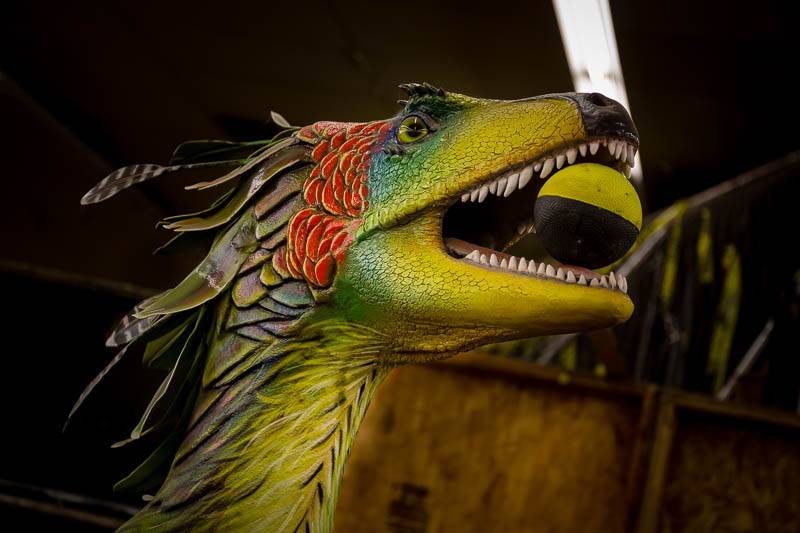Champaign-Urbana is a community with cool, talented people who produce cool, interesting stuff both for business and for pleasure. None of this is news, everyone who reads Smile Politely is inundated with notices about: local film festivals; dance troupes performing on world-class stages; terrifying Haunted Houses; and new business ventures that combine the talents of actors and brainiacs to make it fun for you to escape a locked room. It’s always something, and recently, an unofficial common thread among many of these unique events seems to be Taylor Studios. Enough cool, talented people featured by Smile Politely for other reasons happen to work at Taylor Studios, that it only seemed fitting to take a closer look at the company.
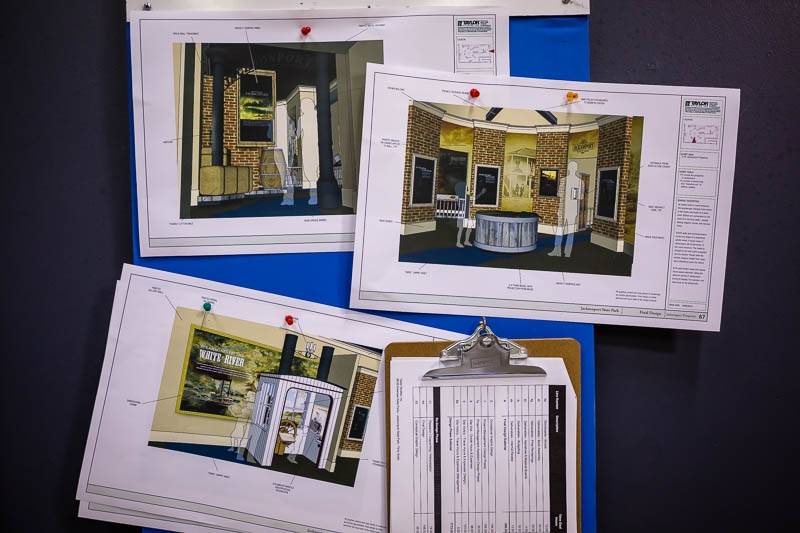
3D interior design renderings for an upcoming project
Taylor Studios is based out of Rantoul and has been creating museum exhibits for 25 years. Co-created and currently helmed by Betty Brennan from Streator, Illinois, legend has it that the company began “in a renovated chicken coop, a garage, and a kitchen table in rural central Illinois.” Over 400 museum exhibits for national and international clients later, the company now occupies two buildings: one a re-purposed Wal-Mart affectionately referred to as “Taylor-Mart” and the second being a two-story converted apartment building. Clearly, the company has grown without outgrowing its apparent philosophy — Taylor Studios creates the perfect product using the resources at hand.
President Betty Brennan and Marketing Graphic Designer Matt Wiley (pictured below)
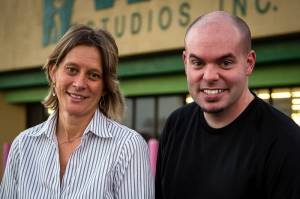 One of the most important resources would obviously be the staff itself. Company president Brennan stresses that the hiring process always starts local, since the area has such a wealth of creative people. In fact, many of her current staff happen to be theatre majors or have other fine-arts backgrounds. Ms. Brennan recognizes not only the value of the creativity, but the resulting skill with budgets, deadlines, and customer expectations that comes from working in the arts. Having experience with the technical aspect of theatre – lighting, set design, construction, props – has a direct benefit when creating an exhibit from scratch. One employee, Michael Hall, observed that being onstage or backstage gives a person a unique perspective for presentation. This awareness of how things appear to an audience is especially useful when deciding how best to construct an eye-catching and logical display for a museum.
One of the most important resources would obviously be the staff itself. Company president Brennan stresses that the hiring process always starts local, since the area has such a wealth of creative people. In fact, many of her current staff happen to be theatre majors or have other fine-arts backgrounds. Ms. Brennan recognizes not only the value of the creativity, but the resulting skill with budgets, deadlines, and customer expectations that comes from working in the arts. Having experience with the technical aspect of theatre – lighting, set design, construction, props – has a direct benefit when creating an exhibit from scratch. One employee, Michael Hall, observed that being onstage or backstage gives a person a unique perspective for presentation. This awareness of how things appear to an audience is especially useful when deciding how best to construct an eye-catching and logical display for a museum.
Eye-catching doesn’t even begin to describe the effect a Taylor Studios exhibit had on us as we were greeted inside the front door of Taylor-Mart by a 7” tall deinonychus. A similar dinosaur was originally created for the Orpheum Children’s Museum, and when Betty’s father saw it, he told her that he needed one for his front yard. Grateful to her father for his support of her business venture, the company’s president commissioned a copy which stood outside her father’s home until it was stolen. At that point, the company re-made the model, this time entirely out of metal and with more creative flourishes such as feathers and metallic paint, and this too-heavy-to-steal version was proudly displayed for years. Now it lives inside the new facility as a playful greeter and example of just what Taylor Studios can accomplish for its clients.
Sculpt of a 1942 WWII Japanese Pilot for the USS Midway Museum (pictured below)
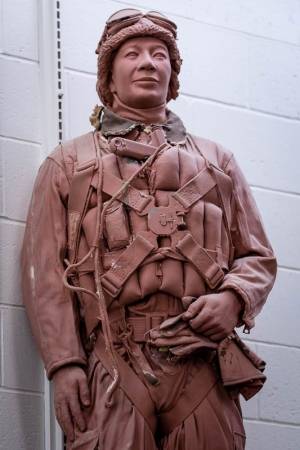 The clients themselves are as unique as the company. Taylor Studios has created exhibits for institutions locally, such as the aforementioned Orpheum, the Beckman Institute, Miller Park Zoo in Bloomington, and the Free Canteen memorial in Streator, Illinois, part of which was donated. Their clients are just as often far-flung and notable: at the time of our visit, the fabrication facility had just been emptied of life-size body-cast statues of soldiers for an exhibit at Quantico. Canadian National Parks, the Audobon Society, the National D-Day Musem in New Orleans, and Bermuda Underwater Exploration Institute are just a few others that stand out. Since employees often get to go install the exhibits, you can guess that these are some of the more popular assignments.
The clients themselves are as unique as the company. Taylor Studios has created exhibits for institutions locally, such as the aforementioned Orpheum, the Beckman Institute, Miller Park Zoo in Bloomington, and the Free Canteen memorial in Streator, Illinois, part of which was donated. Their clients are just as often far-flung and notable: at the time of our visit, the fabrication facility had just been emptied of life-size body-cast statues of soldiers for an exhibit at Quantico. Canadian National Parks, the Audobon Society, the National D-Day Musem in New Orleans, and Bermuda Underwater Exploration Institute are just a few others that stand out. Since employees often get to go install the exhibits, you can guess that these are some of the more popular assignments.
Taylor employees and clients have to work very closely together in order to maintain the business’ high standards of quality and satisfaction. Hall mentioned that this area was another one where his theatre experience came in handy; having dealt with donors so often in the theatre world, he is quite used to “digging the ideas out of their heads” when a client doesn’t have a clear idea of what they want. Even so, redesigns are a matter of course on sometimes a daily basis, according to a creator named Tim who was making miniscule adjustments to the log-like railing of a streambed cross-section as per the Art Director’s feedback. Navigating and balancing the customer’s desires with the realm of possibility with aesthetical appeal is quite the juggling act, and one that is learned best through experience.
Graphic artist Matt Wiley recounted a situation where schooling itself did not prepare him for the practical application of an image. While drawing up a proposal for the entry to the Children’s Section of a library, the idea was to create a fun entrance by letting the kids crawl through oversized letterpress-style letters. It was quickly realized that a sans-serif font (without the pointy bits, like Arial instead of Times New Roman) would greatly reduce the liability factor and risk of bodily harm. “Not something they teach you in design class”, he added humorously.
Dave welds a steel armature (pictured below)
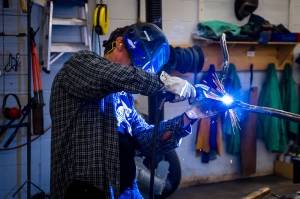 With most projects, many of the departments at Taylor Studios have to work together. Woodshop, metalworking, engineering, graphic design and copywriting collaborate to make a cohesive and practical final product that suits the client’s needs. For Tim’s streambed, a plexiglass barrier would hold in actual water that edges against a bank filled with prop animals and fabricated flora. An exhibit that Michael had just completed used arduinos to program LEDs and dials to demonstrate the efficiency of solar panels on an average house during different types of weather. While every department has its area of expertise, everyone agreed that Taylor is a company suited to “jack-of-all-trade” types.
With most projects, many of the departments at Taylor Studios have to work together. Woodshop, metalworking, engineering, graphic design and copywriting collaborate to make a cohesive and practical final product that suits the client’s needs. For Tim’s streambed, a plexiglass barrier would hold in actual water that edges against a bank filled with prop animals and fabricated flora. An exhibit that Michael had just completed used arduinos to program LEDs and dials to demonstrate the efficiency of solar panels on an average house during different types of weather. While every department has its area of expertise, everyone agreed that Taylor is a company suited to “jack-of-all-trade” types.
These types of people and projects together have laid the course for the business’ new direction: cabinetry. Ok, it might not sound exciting, but think about it — museums need unique and innovative ways to display things, store things, hide unsightly wires, and have replacements easily at hand. Noticing this necessity, Woodshop Lead Spencer Ely (another Illini alum with a theatre background) is heading up a division that will provide commercial cabinetry for businesses that require display and storage units. This diversification will provide more immediate income for the business, serve a local need, and possibly make up for state and national parks and museums having to scale back due to governmental budget cuts.
Graphic Designer Matt Page references design drawings (pictured below)
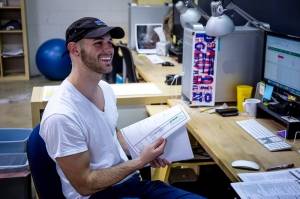 Which raises an interesting point: in these economic times, there is a disturbing trend of anti-arts-education press and action. Legislators and administrators are quick to cut funding to the arts, because they are “superfluous” or at least “unnecessary”. It’s important to recognize that a business like Taylor Studios proves exactly the opposite. Without the creativity, adaptability, aesthetics, presentation, and ingenuity taught by theatre programs, the employees would not be able to create such a quality product. The collaborative skills taught by being one person in a production are invaluable in any industry. Deadlines are inflexible in the arts: the show must go on on the day it is scheduled, teaching responsibility, planning, and prioritizing. Budgets are just as rigid, at least in the academic/amateur sector, overspending isn’t an option. These are professional skills, life skills, and they don’t come from reading Shakespeare in an academic Lit class, they come from experiences that are given to us by performing the arts.
Which raises an interesting point: in these economic times, there is a disturbing trend of anti-arts-education press and action. Legislators and administrators are quick to cut funding to the arts, because they are “superfluous” or at least “unnecessary”. It’s important to recognize that a business like Taylor Studios proves exactly the opposite. Without the creativity, adaptability, aesthetics, presentation, and ingenuity taught by theatre programs, the employees would not be able to create such a quality product. The collaborative skills taught by being one person in a production are invaluable in any industry. Deadlines are inflexible in the arts: the show must go on on the day it is scheduled, teaching responsibility, planning, and prioritizing. Budgets are just as rigid, at least in the academic/amateur sector, overspending isn’t an option. These are professional skills, life skills, and they don’t come from reading Shakespeare in an academic Lit class, they come from experiences that are given to us by performing the arts.
So the next time you’re at the Anita Purves Nature Center, distractedly reading the history wall at Carle, or taking in a diorama at Gettysburg while you’re on vacation, think about everything that went into making that appealing display of information. Then check the credits and see if it was made locally, by Taylor Studios.
All photos by Scott Wells








